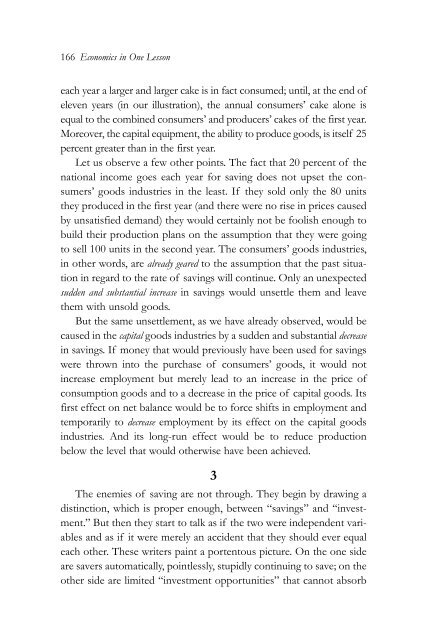1gDdM7w
1gDdM7w
1gDdM7w
- No tags were found...
You also want an ePaper? Increase the reach of your titles
YUMPU automatically turns print PDFs into web optimized ePapers that Google loves.
166 Economics in One Lessoneach year a larger and larger cake is in fact consumed; until, at the end ofeleven years (in our illustration), the annual consumers’ cake alone isequal to the combined consumers’ and producers’ cakes of the first year.Moreover, the capital equipment, the ability to produce goods, is itself 25percent greater than in the first year.Let us observe a few other points. The fact that 20 percent of thenational income goes each year for saving does not upset the consumers’goods industries in the least. If they sold only the 80 unitsthey produced in the first year (and there were no rise in prices causedby unsatisfied demand) they would certainly not be foolish enough tobuild their production plans on the assumption that they were goingto sell 100 units in the second year. The consumers’ goods industries,in other words, are already geared to the assumption that the past situationin regard to the rate of savings will continue. Only an unexpectedsudden and substantial increase in savings would unsettle them and leavethem with unsold goods.But the same unsettlement, as we have already observed, would becaused in the capital goods industries by a sudden and substantial decreasein savings. If money that would previously have been used for savingswere thrown into the purchase of consumers’ goods, it would notincrease employment but merely lead to an increase in the price ofconsumption goods and to a decrease in the price of capital goods. Itsfirst effect on net balance would be to force shifts in employment andtemporarily to decrease employment by its effect on the capital goodsindustries. And its long-run effect would be to reduce productionbelow the level that would otherwise have been achieved.3The enemies of saving are not through. They begin by drawing adistinction, which is proper enough, between “savings” and “investment.”But then they start to talk as if the two were independent variablesand as if it were merely an accident that they should ever equaleach other. These writers paint a portentous picture. On the one sideare savers automatically, pointlessly, stupidly continuing to save; on theother side are limited “investment opportunities” that cannot absorb


